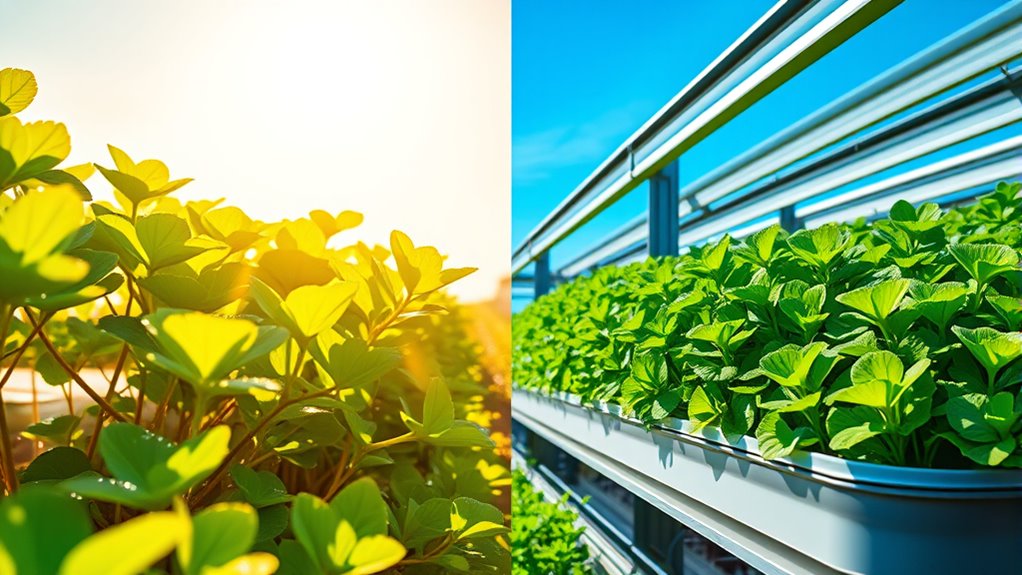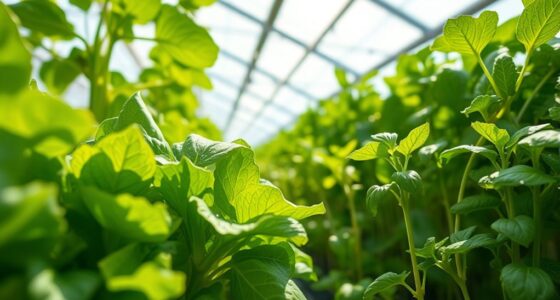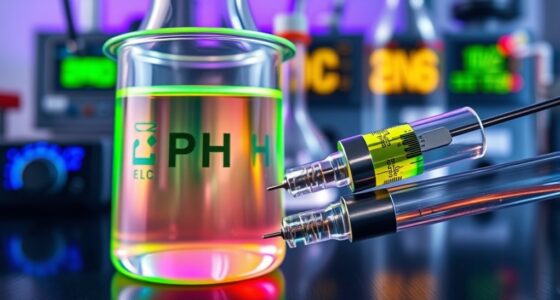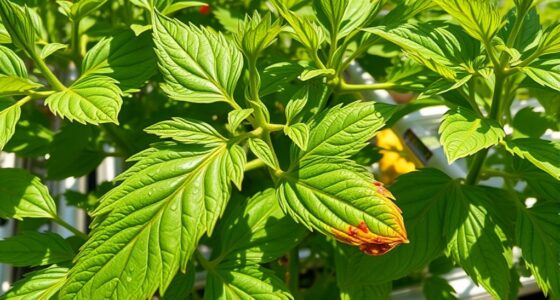In summer, outdoor hydroponics needs careful shading and weather protection to balance sunlight and prevent heat stress, while indoor setups give you precise control over temperature and humidity. Using fans, coolers, or shade cloths helps protect your plants outdoors. Indoors, you can fine-tune conditions for ideal growth. Both approaches require adjustments for weather changes, but mastering these techniques guarantees healthy plants and high yields all season. Keep exploring to discover more tips for summer success.
Key Takeaways
- Indoor hydroponics offers precise climate control, reducing heat stress risks during summer, unlike outdoor systems which rely on shading and weather adaptation.
- Outdoor setups require shading techniques and weather protection to prevent overheating and sunburn, whereas indoor environments can be optimized with HVAC and fans.
- Indoor systems are less affected by weather fluctuations, providing stable conditions for consistent plant growth in hot weather.
- Outdoor growers need to monitor weather forecasts and implement proactive shading or cooling measures to manage sunlight and temperature.
- Both methods require understanding environmental needs; indoor allows fine-tuning, while outdoor demands strategic shading and weather resilience.
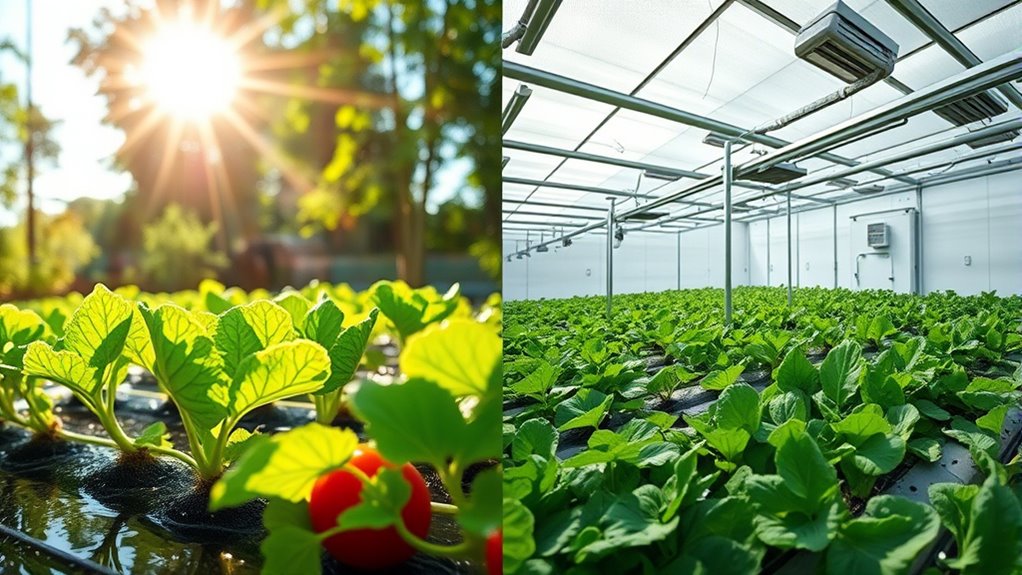
Summer presents unique challenges and opportunities for hydroponic growers. As the temperatures rise and the days grow longer, you need to carefully consider how to manage sunlight and adapt your climate control strategies. Outdoor hydroponic systems are exposed to the full intensity of the sun, which can boost plant growth when properly managed, but also risks causing heat stress or sunburn if not handled correctly. To maximize sunlight management, you might need to implement shading techniques, such as shade cloths or reflective materials, to prevent your plants from overheating or getting damaged by direct sunlight. Adjusting the positioning of your outdoor setup or providing partial shade during the hottest parts of the day can help you maintain a balanced environment, guaranteeing your plants receive enough light without suffering from excessive heat.
Climate adaptation becomes even more critical during summer, especially if you’re growing outdoors. The fluctuating temperatures and unpredictable weather patterns demand that you stay vigilant and ready to modify your system. For outdoor growers, this might mean installing fans or misting systems to regulate temperature and humidity, or using windbreaks to protect plants from harsh gusts. Keeping an eye on weather forecasts helps you anticipate heatwaves or storms, so you can take preemptive action. Conversely, if you prefer indoor hydroponics, you have the advantage of controlling your environment precisely. Summer’s high temperatures make climate adaptation easier within a controlled setting, as you can use HVAC systems, fans, or evaporative coolers to keep temperatures stable. Maintaining ideal humidity levels also prevents issues like mold or root rot, which can become more prevalent during the humid summer months.
Whether you opt for outdoor or indoor hydroponics, managing sunlight and climate requires a proactive approach. Outdoor growers need to be strategic about shading and weather protection, while indoor growers can fine-tune their systems to withstand the summer heat. The key is understanding your specific environment and making adjustments accordingly. By effectively managing sunlight, you guarantee your plants get the light they need for vigorous growth, while climate adaptation measures help prevent heat stress and other summer-related problems. Proper climate control is essential for ensuring optimal plant health and maximizing yields during the hot season. Summer offers plenty of growth potential, but only if you stay attentive and adapt your hydroponic systems to the season’s demands. With the right strategies in place, you can maximize your yields and keep your plants healthy all season long.
Frequently Asked Questions
How Do Pests Differ Between Outdoor and Indoor Hydroponic Systems?
You’ll notice pest diversity varies considerably between outdoor and indoor hydroponic systems. Outdoors, pests are more diverse and abundant due to exposure to the environment, making pest management more challenging. Indoor systems tend to have fewer pests, simplifying control efforts. To stay ahead, you should regularly monitor your setup, use integrated pest management strategies, and keep conditions ideal. This proactive approach helps prevent infestations and maintains healthy, productive plants.
What Are the Energy Costs Associated With Indoor Climate Control?
You’re walking a tightrope with indoor climate control costs, as energy consumption can skyrocket for temperature, humidity, and lighting management. These systems often run continuously, eating into your budget. While climate management keeps conditions ideal for plant growth, be mindful of the costs—it’s like pouring money down the drain if you don’t optimize. Efficient equipment and smart settings can help you strike a balance and save energy.
Can Outdoor Hydroponics Succeed in Extreme Summer Temperatures?
In extreme heat, outdoor hydroponics can succeed if you implement effective cooling systems like shade cloths or misting. These measures help protect plants from scorching temperatures and maintain ideal growing conditions. You should monitor weather forecasts and adjust shading or watering accordingly. While challenging, outdoor hydroponics is feasible with proper climate management strategies, ensuring your plants thrive despite the intense summer heat.
How Does Humidity Impact Plant Growth Indoors Versus Outdoors?
Humidity levels markedly impact your plant growth, whether indoors or outdoors. High humidity reduces plant transpiration, making it harder for plants to absorb nutrients and cool themselves, which can stunt growth. Conversely, low humidity increases transpiration, risking dehydration. Indoors, you control humidity more easily, creating ideal conditions. Outdoors, fluctuating humidity levels can challenge your plants’ health, requiring adjustments like misting or ventilation to maintain perfect transpiration rates.
What Are the Best Practices for Transitioning Plants Between Indoor and Outdoor Systems?
Coincidentally, shifting plants between indoor and outdoor systems requires careful plant acclimation and light adjustment. You should gradually expose your plants to outdoor conditions, increasing sunlight exposure over days to prevent shock. Monitor temperature and humidity, making adjustments as needed. Ensuring a slow transition helps your plants adapt smoothly, reducing stress and promoting healthy growth. This method fosters resilience and optimizes how your plants thrive in either environment.
Conclusion
So, whether you choose outdoor or indoor hydroponics this summer, remember you’re orchestrating the greatest plant symphony of your life. With the right balance, you could grow giant, lush plants that practically reach for the sun or produce crops so abundant they’ll overflow your space. It’s like becoming a summer gardening superhero—controlling sunlight and climate to reveal nature’s ultimate secret. Get ready to amaze yourself with a garden that’s truly out of this world!

